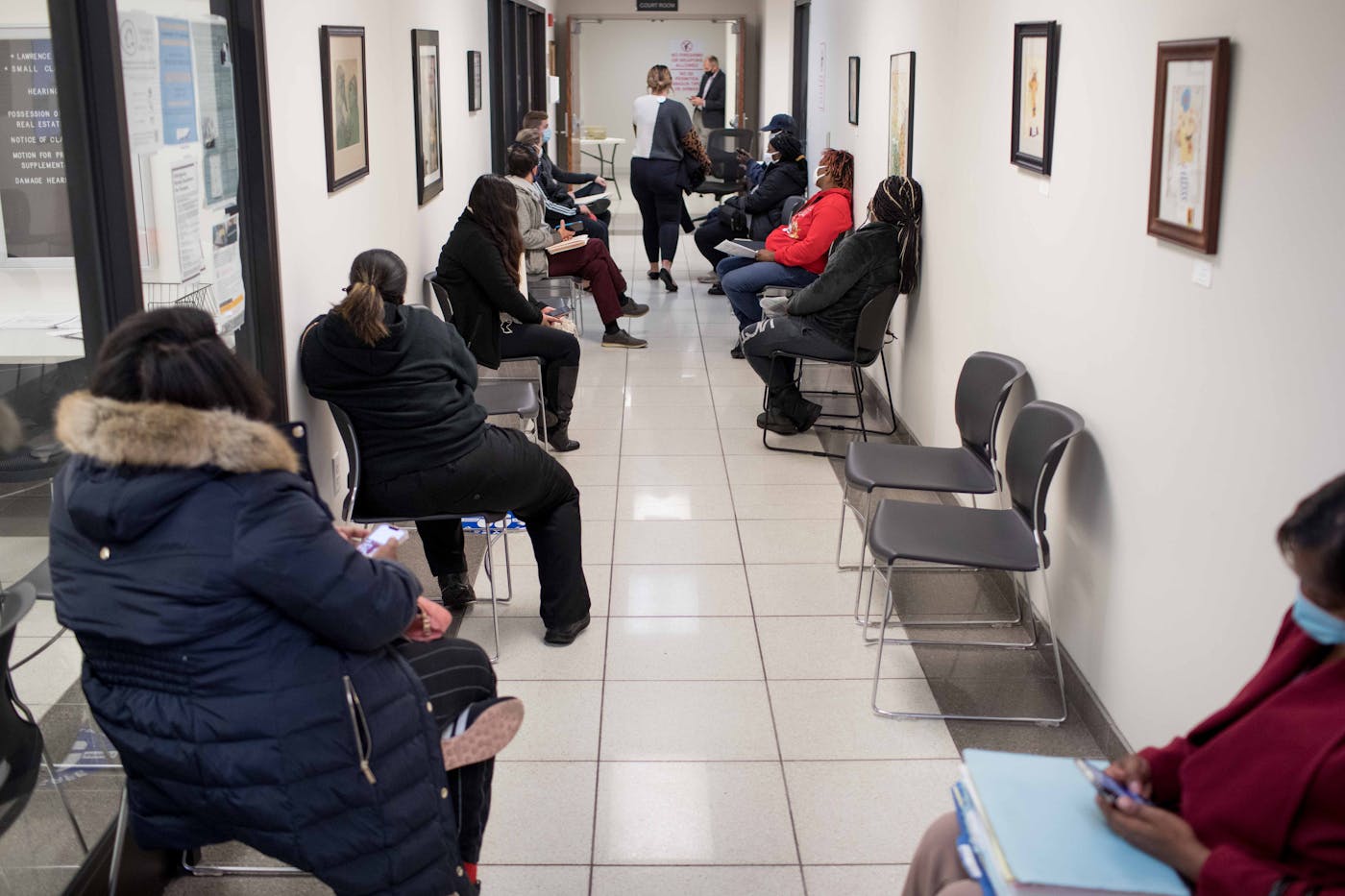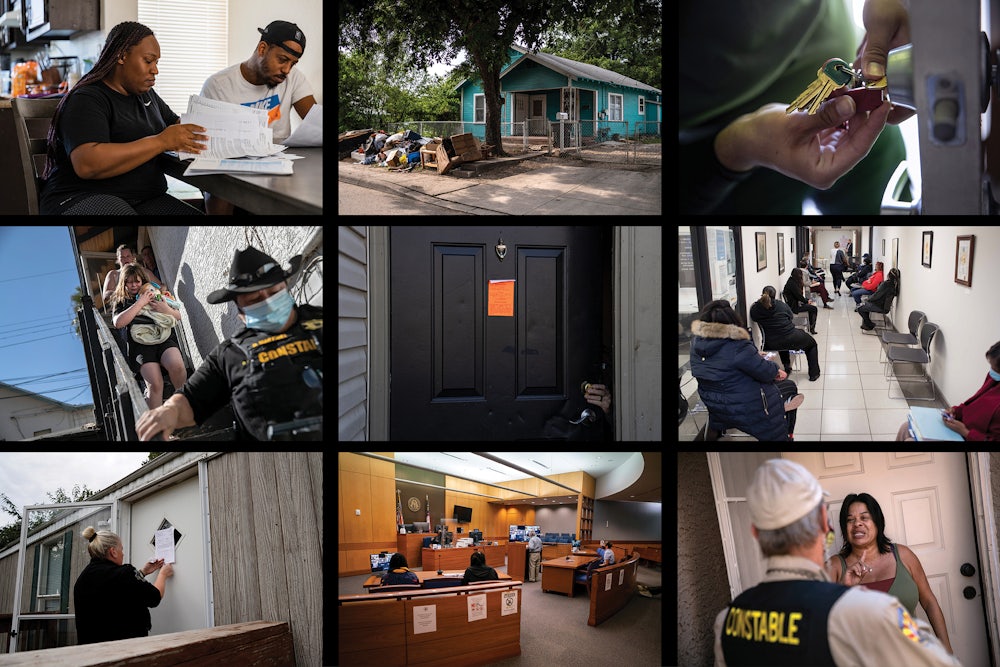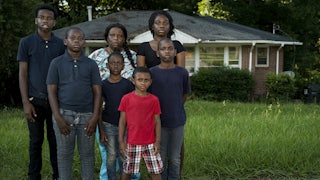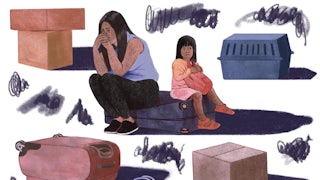As soon as Martha moved into the one-bedroom apartment in Williamsburg, Brooklyn, shortly before Christmas 2019, she wanted to leave. The buzzer was broken, so Martha, who is asthmatic, had to walk down four flights to accept deliveries and let in visitors. The floors slanted noticeably toward the middle of the building. The bathroom seemed put together at odd angles. The living room, a narrow, windowless hallway, also served as nursery and bedroom for her two-year-old daughter and six-year-old son. Because there was so little space, Martha was forced to squeeze the couch next to the crib, and the crib next to the bed. All she put on the walls were a few removable decals of zoo animals and a phrase: “This is our life, our story, our home.”
Martha hadn’t been sure she should take the apartment in the first place. When she left New York City’s shelter system with her two children, she was given a voucher to cover rent, along with a list of landlords who would supposedly accept it. All of them refused. Finally, she put an ad on Craigslist. When Florence reached out to her, Martha wondered why the seven-unit brick building the elderly woman owned and managed was empty—it was in a nice neighborhood, there was a good school almost directly across the street, and there were businesses nearby. Florence blamed the open units on the subway construction that at the time had left the neighborhood isolated.
By nature, Martha, who is 41, is not confrontational. Even when she’s not struggling with asthma, it’s hard to hear her speak, and while she is warm with those she knows, with strangers she remains reserved. The occasional subtle eye roll is about as expressive as she gets. The same could not be said of her landlord. “I think it was the first week I moved in there started to be problems,” Martha told me. One day, she asked a friend to receive a furniture delivery for her while she went to an appointment. Florence tried to block him from going up the stairs. Martha, she said, shouldn’t have visitors because she hadn’t been allowed them in the shelter. Before other tenants moved into the building, the landlord kept knocking on Martha’s door, upset about the sounds of young children running on the floor. Frequently she yelled at Martha; once, she threatened to beat her son. After other tenants arrived, she posted accusatory signs around the shared stairway. Martha was trying to DESTROY THE APARTMENT, one sign read, AND RUN THE WATER 24 X 7 TO IRATE THE LANDLORD. (Florence did not respond to any of my requests for comment.)
From nearly the day Martha arrived, Florence accused her of letting people live with her who weren’t on the lease. Martha’s boyfriend came over regularly, but he had his own apartment in the Bronx. Six months after Martha moved in, a note was slipped under her door. Martha had violated the lease, the note said, and Florence wanted to evict her.
The threat wasn’t serious, Martha knew. The landlord had typed it out herself, and it had no court seal or stamps on it. But Martha also knew she needed to find somewhere else to live as soon as she could. That was easier said than done. Just down the street from her apartment, a shiny real estate office with the name Rentopia advertised rentals around Brooklyn. It would be utopian if she could walk into that office and sign a lease; there was no way she could afford an apartment on her pay working as a certified nursing assistant at a nursing home. She worked only on weekends, because that was when her boyfriend could watch her children, and she made just $200 a week. (To work full-time, she’d have to pay for infant and after-school care, at an average annual cost of $30,000 for the size of her family in New York state.) So Martha, despite her difficulties in the building, stayed where she was.
In May 2021, her daughter cut her toe on one of the cracked tiles in the kitchen and had to go to the emergency room. Martha covered the worst parts of the broken floor with mats. During a storm that summer, rain started pouring through the bathroom ceiling. Florence removed the ceiling light, leaving a gaping hole, but made no other repairs. Nothing was wrong, she claimed, with the roof or the pipes. After the storm, Martha called the city to find out how to file a claim about the need for repairs. Given everything the landlord had put her through, a city employee advised her to file a claim of harassment, too. Martha decided to do both.
That October, she and her kids started getting headaches and nausea. When she called 911, the fire department, fearing carbon monoxide poisoning, disconnected the gas stove. Florence refused to reconnect it, so Martha had to make do with a microwave, a rice cooker, and an air fryer. Eventually she bought a hot plate, despite her concern that it was a fire hazard, because her children missed her homemade pancakes.
Back in September 2020, the Centers for Disease Control and Prevention had banned evictions of those who had suffered hardship thanks to the pandemic. Many states instituted their own versions of the protection, too. Under the moratoriums, eviction filings fell 50 percent below the pre-pandemic average. Researchers at the Eviction Lab at Princeton University estimated that the measures prevented at least 1.36 million cases from being filed. New York City saw less than a quarter of a typical year’s cases. At the end of 2021, Martha filed a hardship declaration. Her landlord tried to challenge it, arguing that Martha hadn’t experienced enough hardship in the pandemic to qualify, but a judge decided in Martha’s favor. The moratorium “gave me a little peace of mind,” Martha said. “At least not having to come home and imagining she’s going to lock me out.”
Martha is the kind of person whom, at one point, everyone was trying desperately to keep housed. She worked on the front lines for most of the pandemic, even while pregnant with her youngest. She had Covid-19 twice; she believed she’d contracted both cases while caring, with minimal personal protective equipment, for unmasked nursing home patients. The first time she fell sick, she was about four months pregnant with her third child; she almost lost her baby, and got so short of breath she thought she was going to die. If she were kicked out of her home, she had nowhere to go.
In August 2021, the Supreme Court sided with a coalition of landlords and real estate trade groups and struck down the CDC moratorium. By the end of the year, under pressure from the same interest groups, only three states, including New York, retained eviction bans; now they’re virtually all gone. One of the few remaining protections was what had been baked into the federal rental assistance that was part of the American Rescue Plan. In New York, those who received the money before it dried up, and whose landlords accepted it, are protected from eviction for one year if they can’t pay rent or if their lease expires. But they can still be evicted for other reasons, such as causing a nuisance or owing rent beyond what the assistance covered. The money has also already been disbursed, so while the application process is still open and those who apply are shielded from eviction while their applications are pending, they stand little chance of actually getting help.
Martha fell outside even those protections. She didn’t owe rent, because it was fully paid by her voucher, so she couldn’t apply for assistance. Her landlord, like those in the tens of thousands of cases that went through New York courts each year in pre-pandemic times, could simply refuse to renew the lease when it was up; she needed no particular reason. Just as New York’s eviction moratorium was set to expire (the last day was January 15 of this year), Martha opened her mailbox to find court papers in it. “Oh, no,” she thought. “It’s official.”
She knew, perhaps better than most, that Covid-19 wasn’t over. “People at the nursing home are still dying of it,” she said. At work, she still had to deal with the fear, the sickness, the death; coming home, she had to worry about her children soon having no place to live. “It’s just stressful,” she said, in her typical way of saying a lot without saying much.

When the CDC eviction ban fell, many expected a tsunami of evictions. For a while, some remaining renter protections, coupled with federal assistance, held back the flood. Nevertheless, bit by bit, eviction filings climbed to the point that there are now an “alarming number of places that have exceeded 100 percent of the historical average,” said Peter Hepburn, a research fellow at the Eviction Lab. In a survey conducted in late 2021 of 119 legal aid and civil rights attorneys across the country, two-thirds said eviction cases had risen since the end of the CDC ban. In Las Vegas, Nevada; Columbus, Ohio; Gainesville, Florida; and Houston, Texas, eviction filings returned to normal. In Harris County, Texas, where only 13 percent of people with eviction cases invoked the moratorium to delay or prevent their removal, eviction filings are already back to pre-pandemic levels. “There was a dip about two years ago,” noted Dana Karni, manager of the Eviction Right to Counsel Project at Lone Star Legal Aid, but now “everything’s been kind of business as usual.”
In Florida, which never enacted its own eviction moratorium, the CDC ban “certainly stemmed the tide,” said Jacksonville Area Legal Aid president Jim Kowalski, and when it fell, there was little standing between tenants and removal. Federal rental assistance filled in some holes, but it’s running out. “The wave didn’t happen, because the duct tape held,” Kowalski said; now that duct tape is being ripped off. “What is that going to look like? We don’t know.” The same has been true in Ohio, where, under the CDC ban, courts allowed eviction cases to move all the way forward except for the final step of forcing someone out. “We had a very tiny percentage of cases that were actually, fully stalled because of the CDC,” said Robby Southers, a managing attorney at the Franklin County Municipal Court Self Help Resource Center. During the pandemic, the courts capped the number of eviction cases heard every morning, but the cap has been subsequently lifted to 100 per morning. The rule is “slowing down the process a little bit,” Southers said, “but we’re reaching our limit almost every day.”
In cities around the country, as eviction filings climb above pre-pandemic levels, the slow-moving storm is building up strength and speed. “We’re at the beginning of it,” said Marie Claire Tran-Leung, evictions initiative project director at the National Housing Law Project.
In places with stronger protections, bureaucracy may be part of why the tsunami didn’t hit when expected. Philadelphia runs an eviction diversion program that helps tenants reach agreements with landlords before going to court. But lockouts started back up in July of last year, including against people who would have been protected by the CDC moratorium, said Kadeem Morris, supervising attorney in the Housing Unit at Community Legal Services of Philadelphia, and eviction cases are proceeding. The city is working through a backlog at a rate of 100 lockouts a week, the max it can handle with its current capacity.
In October in downtown Philadelphia, a Black woman who had applied for rental assistance months earlier still hadn’t been approved, which meant she wasn’t yet granted the protection from eviction that such funds would offer. When a legal aid lawyer, who promised to help look into her application, asked if she would be able to afford her rent after assistance was used up, she said, “Good question.” She’d fallen behind, she said, because she lost both her mother and sister to Covid, and she needed more time to get back to normal. In a housing courtroom, a white attorney represented a handful of different landlords, one of whom sought a default judgment against a tenant who didn’t show up and owed $9,149 in back rent. A couple were trying to kick out a tenant who owed just under $3,000 in rent.
New York state’s eviction moratorium, which was relatively strong, successfully kept evictions at bay while it held, especially coupled with preexisting protections, such as New York City’s law that low-income people in housing cases have a right to legal representation. But without the moratorium and with no extra rental assistance, filings are climbing. “Cases are moving forward,” said Jennie Stephens-Romero, a supervising attorney at the advocacy and legal aid organization Make the Road New York and one of the lawyers on Martha’s case. A “vast majority” of those cases, Stephens-Romero added, wouldn’t have gone anywhere under the state moratorium. They may not be moving as quickly as they used to before the pandemic, because the court doesn’t have the capacity to operate at full speed, but the volume is increasing. There were so many cases during March and April that in Queens and the Bronx, the right to counsel notwithstanding, there weren’t enough attorneys for everyone who needed them.
And while the full lockdowns of early 2020 are long gone, the financial difficulties wrought by the pandemic are still hammering people, particularly low-income renters. Out of the dozens of eviction cases Make the Road had in mid-March, only one or two tenants had the money to pay everything they owed. Many people still don’t have regular work; those who do may be in such a deep hole from earlier that they can’t climb out. Between January 2021 and January 2022, New York City rents rose 33 percent, nearly double the national rate. As of last count, less than 5 percent of all apartments in the city were even available, virtually none of them in the affordable range. “There are so many tenants without protection,” Stephens-Romero said. If the city has avoided an eviction cliff so far, it’s simply because cases “haven’t wormed their way through yet.”
Because the pandemic had slowed the operations of housing court, Martha’s lawyers hoped her case would proceed slowly. Instead, a conference between her legal team and the landlord in front of a judge—an attempt to resolve the eviction case without going to trial—was scheduled for early March, less than two months after the moratorium expired. Martha was too nervous to join it. She worried she’d be given only a month or two to move. “I’d have to put my stuff in storage,” she told me. “I’ll have to go back to the shelter.”
Two years into the pandemic, courtrooms still hadn’t smoothed out the technological kinks of remote hearings. As the Microsoft Teams call began, Judge Kenneth T. Barany was asking one of the participants to unmute himself and encouraging Martha’s lawyer to speak closer to her microphone. All that was visible from Barany’s screen were fluorescent-lit rows of benches in an empty courtroom, so still that at times it appeared to be a frozen image. Florence remained invisible, too, her camera off.
Once the technical challenges were worked out, Barany asked Martha’s lawyer some routine questions, then turned to the landlord: Was she still receiving voucher money? Instead of answering, Florence launched into a long story about how she had gone to the city’s voucher office and told them to “cease and desist” because she wanted Martha out. Barany tried to explain why a settlement would be in everyone’s best interest, including the landlord’s: With a settlement, she could still get the assurance that Martha would leave by a certain date, while Martha would, in theory, get enough time to find other housing. Florence responded by listing her grievances in a loud and panicky cadence. “I didn’t birth them,” she blurted at one point, referring to her tenants. “My house is my castle,” she yelled at another. She refused to fix the leaking ceiling and disconnected cooking gas. “They have the nerve to tell me to fix something that’s mine,” she said. Despite her meanderings and outbursts, the judge assured her repeatedly, “I understand your position.”
He showed less empathy for Martha’s situation. When her lawyer noted the difficulty of looking for a new place with a small baby, Barany was unmoved. “The flip side is she wouldn’t be dealing with that issue if she left early,” Barany responded. “Both sides of the coin on that one.”
But in the end, he got fed up with Florence’s digressions and set the case for trial in mid-March. Until then, Martha had one reason for optimism: On March 22, she was scheduled to have an appointment with the city’s voucher agency, from whom she hoped to hear that she’d be given more money to cover rent because she’d had a baby since she last applied. Maybe, with a larger voucher in hand, she’d be able to find a landlord willing to rent her an apartment big enough for a family of four.
If not, she had practically no options. She had put herself on every affordable housing and public housing wait list that she could find, but the lists never seemed to inch forward. Her voucher covered up to $1,557 in rent, and there are rules against landlords discriminating against people who use them, but even if she could find a big enough apartment for that amount—she knew she needed more than one bedroom, given how old her son was getting—she doubted she could find anyone willing to accept it. She couldn’t move in with her boyfriend; he rented from a landlord who prohibited children, and she was loath to get an apartment with him anyway. “I don’t want to be left in a situation where I have nothing again,” she said.
One of Martha’s deepest fears, besides those that visited her in the nightmares she still had about her ex-boyfriend’s violence, was ending up in the shelter system, as she had after she extricated herself from her former relationship. Almost a decade ago, while living near Scranton, Pennsylvania, in an apartment her parents owned, she started dating John,* who lived in New York. After Martha’s father died unexpectedly, she moved to the city, where she had no family and knew no one, to live with him. The abuse began about a year later, and went on for another three.
Once she started talking about leaving, John cut her out of their joint accounts. One day, when he left the apartment after an episode to smoke a cigarette, she realized, “I need to get out of there, I need to survive.” She locked the door and called the police while her three-year-old son napped. “He has a fear of police to this day, because what he woke up to was the police all over the place,” she said. For eight months, she and her children—starting when her daughter was only six months old—lived in a domestic violence shelter, sharing a two-bedroom apartment with another family. They were then placed in a homeless shelter, where they stayed for nearly two years. In the shelter, she survived on about $400 a month in cash welfare and what she could get in food stamps.
It was the practical challenge of living in a shelter again as well as the principle of it that scared her. Shelters don’t allow visitors, so her current boyfriend wouldn’t be able to watch her children when she worked, as he did now. She’d have to quit her job. She considered moving back home to Pennsylvania, where her mother and most of her five siblings still lived, to the big house that her father built himself when she was about five. Her boyfriend had told her he would come with her; he could transfer his job at Target relatively easily. But John had visitation rights to see their daughter every other weekend. Martha had to drop the girl off near the apartment they had shared when he abused her. She used to send her son, too, who knew him as a father, until her son told her that John made him do squats until he cried. To move to a different state, she’d have to get his permission, and it was unlikely he’d agree. Most lawyers, an attorney told her, wouldn’t touch a case like that. Her mother had remarried, to a man Martha barely knew, and her sister and her husband already lived in her mother’s basement. She worried, too, about having to rely on her boyfriend’s income before she was able to transfer her certified nursing assistant license to a new state. She had already been trapped once. “I want to do everything myself so that I’m not in that situation again,” she said.
Before the mid-March hearing about her harassment claim against her landlord, Martha had never had to speak in court. She had talked to a grand jury in her domestic violence case, but it never went to trial, because her ex-boyfriend pleaded down. When she dialed into the video call for the hearing, she was nervous, not least because her children were at home. She put her daughter in the living room and kept her older son and baby in the bedroom with her to stop the older kids from fighting.
Florence, a small, thin Black woman whose mask was constantly falling off her nose, was sitting in person in the courtroom. Martha, her mouth pulled into a tight frown, sat close to the camera, bouncing slightly, trying to keep the baby quiet just off camera as long as she could. The female judge went through a list of actions the landlord was supposed to have taken and repairs she was supposed to have made: Did she provide access to the heating system? No. Did she fix the mold in the bathroom? “She is nasty, she don’t clean her bathroom,” Florence replied. Did she get an exterminator for the mice? No. “I’m not going to talk to these people.” Did Martha have gas, as legally required? “The gas is on her.”
The meeting got interrupted by someone dialing in; the man had a court date over a landlord who had accused him of owing money he said he didn’t owe. Once the judge told him he needed to call back later, it was Martha’s turn to answer her lawyer’s questions. As soon as she unmuted her line, children’s voices wafted in. As she moved her baby around in her arms, trying to calm him with a pacifier, his face flashed across the screen.
Martha’s lawyer shared her screen and displayed the evidence: a text exchange in which Martha told her landlord about needed repairs, and Florence responded, “You are not my problem”; signs she’d hung in the common areas accusing Martha of refusing to leave. When asked whether she objected to the evidence, Florence used each opportunity to launch into a tirade. As her landlord spoke, Martha’s face was stony, but as soon as the older woman was done, she wiped an eye.
Then Martha’s boyfriend was sworn in. His scruffy goatee and mustache filled the screen; the apartment ceiling framed his face. Without having heard Martha’s answers, he confirmed the same problems with the apartment: no light in the bathroom, leaks in the ceiling, cracked tiles in the kitchen, no gas. When the landlord got a chance to question him, she asked repeatedly if he lived in the apartment with Martha. “No,” he answered. “I live in the Bronx.” Martha’s lawyer objected; the judge sustained her objections. Still, Florence would not stop. Eventually, the judge reminded the landlord that whether Martha’s boyfriend lived in the apartment was not the point—the hearing was about Martha’s allegations of harassment.
Nevertheless, whenever Florence had the floor, she aired her list of grievances against Martha again, in an unvarying yell. It was clear that whether or not the eviction was the day’s topic, she wouldn’t stop pursuing it until Martha was gone. “I don’t want no money,” she said. “I just want an eviction date.” When Martha’s lawyer tried to question her, she refused to confirm basic facts. She no longer considered herself to be Martha’s landlord, she said: “The city is her landlord.”
Martha’s lawyer played audio from a January hearing in the harassment case. The landlord’s voice came on. “Governor Cuomo and Hochul choose to keep people in my building that I hate,” she said. “Tell them, ‘Get your big fat bottom out of my place.’” Martha’s baby had fallen asleep on her chest. She looked down at him as she wiped away tears. Another recording played. “I’m not fixing anything,” Florence said on tape. “Tell her to get her white butt out of my place.” When Martha’s lawyer questioned the woman, she refused to answer. “You hear exactly what I said,” she stated. “You have my answers, stop asking what you know already.” Martha’s lawyer asked the judge to strike the landlord’s testimony if she refused to respond, but the judge simply urged her to keep asking questions. It was no use; the landlord refused to respond. With some skepticism, the judge struck her testimony. The government, Florence yelled again, was blocking her from evicting Martha. On that note, the hearing finished. The judge said she would send a copy of her decision once she had made it. Martha signed off. Her older son, she told me later, had listened to everything. With the mic muted, he objected every time he thought the landlord was lying.
March 22, the date of Martha’s voucher appointment, came and went without a phone call. She emailed her contact person and left a voicemail, but got no reply until five days later. When she finally reached someone, she was told the appointment had been changed to April 25. “I am just so frustrated,” Martha texted me, “so worried.” Recently, she’d spoken to a neighbor in her building who was also facing eviction. That person had been given until June to leave. “I am hoping I will get around the same time, so I can get out ASAP,” she said.
Short of reinstating eviction bans, there are other ways of helping people stay in their homes. New York lawmakers recently considered a bill that would cap rent increases and require landlords to have a “good cause” for evicting tenants, such as failing to pay rent, causing a nuisance, or making room for landlords to use an apartment themselves. If the state had had such a law on the books, Martha wouldn’t have faced removal. During the pandemic, some cities and states have followed New York City’s lead and instituted a right to counsel in eviction cases. Others, like Philadelphia, have eviction diversion programs meant to keep tenants out of court in the first place. There’s certainly interest in doing something: In 2021, states and localities passed or implemented 130 new policies meant to keep tenants in their homes.
In June 2021, some members of Congress proposed legislation that would create a permanent fund similar to the rental assistance the federal government offered in the pandemic, with $3 billion a year for low-income households that need help covering an unexpected inability to pay rent. “We’ve created the testing ground for emergency rental assistance as a concept,” said Hepburn of the Eviction Lab. “A failure to build on that success would be tragic.” But so far, the bills have gone nowhere.
The best way to prevent eviction is to ensure that Americans make a living wage and can find decent housing that they can afford. There’s currently a shortage of seven million affordable homes available for extremely low-income renters—bridging the gap requires, at least in part, building more affordable housing, which takes money, time, and willpower. None of these changes were going to come fast enough to ensure Martha’s family a place to live.
Martha’s eviction trial, in early April, was among the first to happen in person after the pandemic pushed everything onto video calls, but pandemic protocols were still in place, including temperature and symptom checks at the courthouse door. That morning, Martha sat quietly in front of the judge. Her hair was done up in a neat braided bun. Eyeliner rimmed her gray eyes. Her older kids were at school—after dropping them off, she promptly got into an Uber to make it to the courthouse on time, despite her son’s protests that he wanted to go with her. Her boyfriend was watching the baby at the apartment. Throughout the hearing, she worried about being able to get home to her kids in time. Immediately to her left were her two lawyers, both young white women in smart, dark suits. On the far right sat her landlord. Judge Barany, who had wavy salt-and-pepper hair and thick caterpillar eyebrows, sat in front of them on his dais, facing the pewlike benches at the back of the room. The fluorescent lights in the ceiling bore down on dirty linoleum floors. Before the pandemic, those benches would have been crammed with people waiting for their hearings, as would have the hallways. But cases had only just started returning to the courthouse. In early April, only five were scheduled per hour.
Barany began off the record, trying again to convince Florence of the prudence of a settlement. It was in her best interest to settle both the eviction case and Martha’s harassment case at once, he argued, rather than go forward with an actual trial. “Both sides, put away your past, put away your feelings,” he said. A trial could take days, and it would take another 60 days for him to reach his decision. Martha’s legal team could then appeal, pushing the deadline back further. Once the landlord had the legal right to seek a warrant for Martha’s removal, the warrant itself would take weeks to be processed. By the time the whole thing was wrapped up, it would be summer anyway. An agreement now would get Martha out in about the same amount of time, he argued. “You’re only spiting yourself by not accepting it.”
Martha’s team was willing to settle. They had no legal recourse to stop the eviction, and Martha had, after all, been trying to leave for three years. Martha stayed silent as the judge, who spoke about her as if she wasn’t there, and Florence went back and forth. As the two seemed to near agreement, she shook her head. The landlord didn’t accede easily. But in the end, she allowed Martha’s lawyers to write up a settlement. They filed into the hallway, and her lawyers set about writing out terms, pressing the pen as hard as they could on the three layers of carbon paper that had sat unused for two years. The lawyers decided on two requests: an eviction date at the end of July (rather than the end of June) and a neutral recommendation from the landlord for future rentals. “I’m nervous,” Martha told me as they hammered out the details. She wanted the whole experience to be over, but settling meant giving up on her harassment case and any hope of getting Florence to make repairs to the apartment. “Basically, nothing is going to happen to her,” she said.
The day before, it had rained, and she had had to move all her belongings out of the bathroom, where the ceiling was leaking. She set up a bucket to catch the water. She was afraid the whole roof would soon collapse. She had to keep reminding her kids not to run in the kitchen so they wouldn’t get hurt on the cracked tiles. A mouse problem had made her afraid to put the baby on the floor, where he might be exposed to droppings. “I just didn’t want her to get away with it,” she told me. She was also worried she wouldn’t be able to find a place by July. Her credit was much better than it used to be, but she knew firsthand the kinds of tricks landlords used to avoid taking vouchers, even if they’re legally obligated to. They would set the rent just dollars above what her voucher would cover, knowing it was illegal for her to make up the difference.
Unlike the majority of American tenants—just 10 percent of tenants nationally go to eviction court with a lawyer, compared to 90 percent of landlords—Martha had lawyers at her side. That she had legal representation may have been part of why the judges were lenient with Martha’s landlord, who’d taken the unusual step of forgoing it. Still, housing court is set up in landlords’ favor; the only avenues through which it lets tenants sue are harassment or repairs cases, whereas landlords have multiple paths for going after tenants. In Martha’s case, it was clear who had the power. Back in the courtroom, Barany took immediate umbrage at the lawyers’ requests. When Martha’s lawyer spoke up, he accused her of interrupting, despite his having allowed Florence’s countless interruptions. “She’s had all this time,” he said of Martha, arguing that when she had sought the protection of the state’s moratorium in 2021, she should also have kept trying to find a new apartment. “She’s known what’s been going on…. The woman wants her space back.” At first, he refused to force Florence to give Martha a neutral recommendation, then he relented. In the end, he allowed the landlord to seek an eviction warrant on July 15, putting the actual eviction off until August 1.
Florence signed first, then Martha. At the very end of the proceeding, Barany finally addressed Martha directly. “Good luck to you, ma’am,” he said. “I wish everybody the best. Stay safe.”
When we said goodbye in the courtroom hallway, Martha had no idea what lay ahead. Her lawyers doubted that she would find a new apartment by July. If she didn’t, they would ask for more time, but at that point they’d likely only be able to get her a month or so more. Martha was hopeful that her voucher appointment wouldn’t get rescheduled again, that the city would offer her a higher rent subsidy. “I still got to find a place,” she said. She was willing to move anywhere that would have her.
This article was supported by the journalism nonprofit the Economic Hardship Reporting Project.






